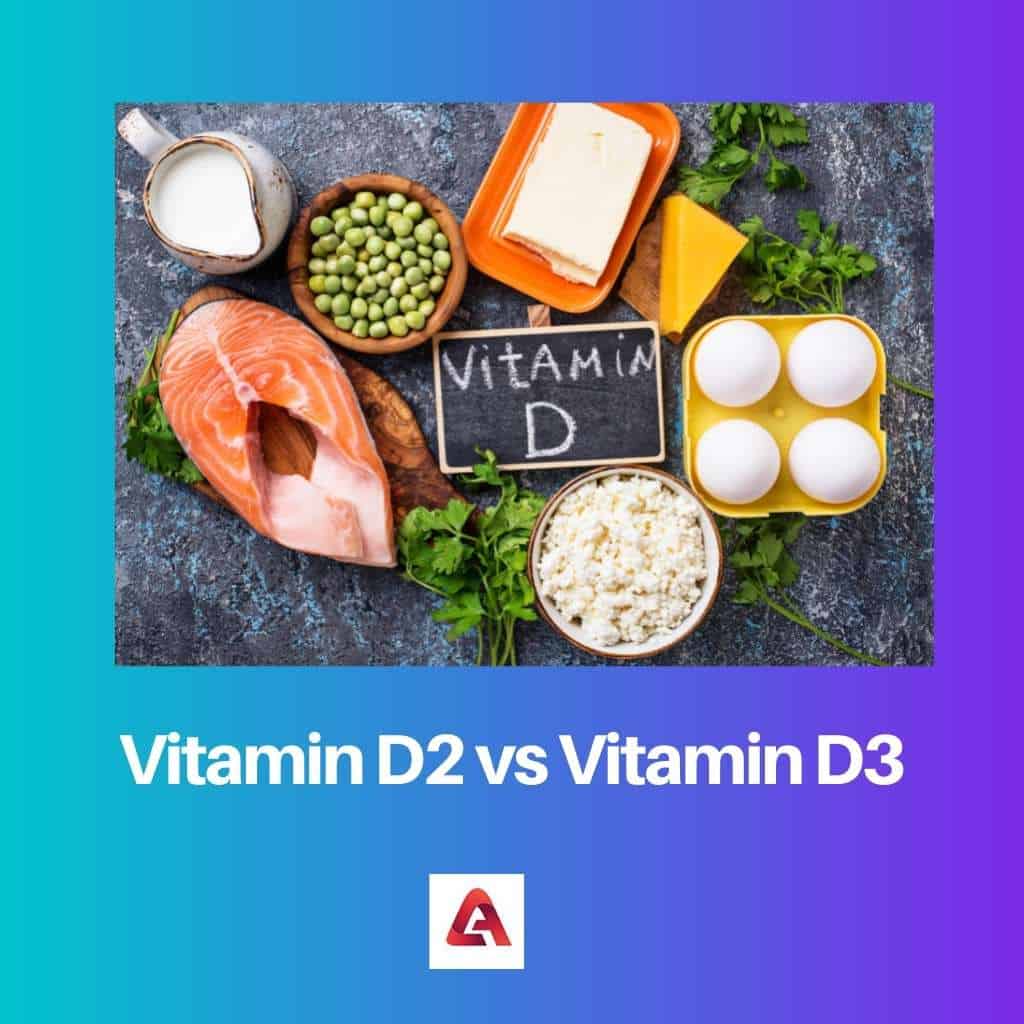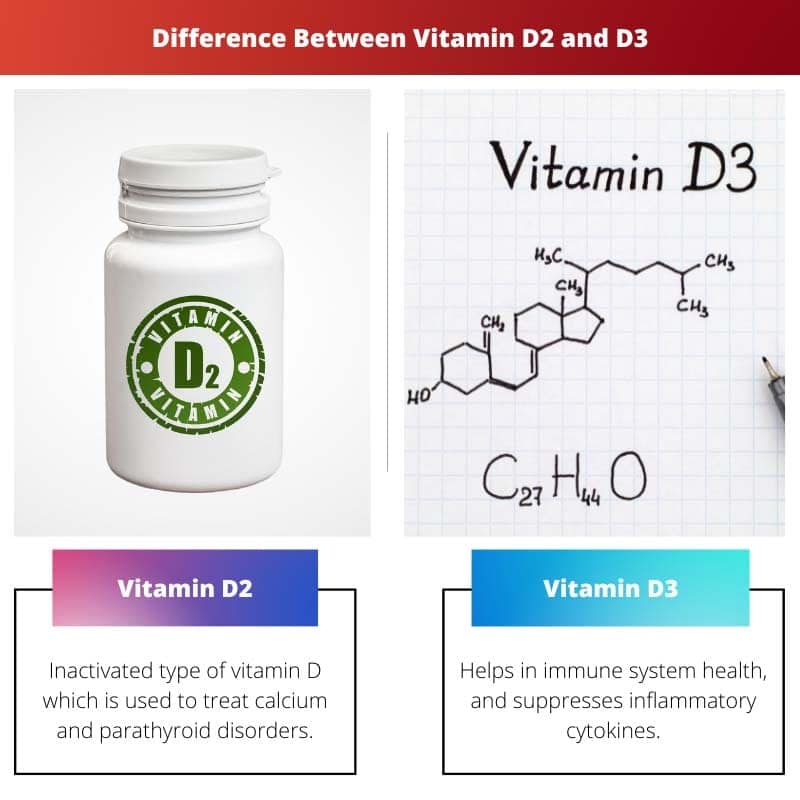Vitamin D is a fat-soluble vitamin that improves calcium absorption, regulates bone formation and aids immunological function. When skin is exposed to sunshine, it creates vitamin D.
But, if you spend most of your time inside or reside in a cold climate, you’ll have to supplement your diet with this vitamin.
However, because significant natural sources of this vitamin are scarce, obtaining appropriate levels from your diet may be hard.
People frequently do not get adequate amounts of this vitamin for these reasons. Vitamin D is basically of two types, D2 and D3, and knowing the distinction between the two is essential.
Key Takeaways
- Vitamin D2 (ergocalciferol) is derived from plant sources like fungi, while Vitamin D3 (cholecalciferol) is obtained from animal sources like fish liver oil and synthesized in the skin.
- Vitamin D3 is more effective at raising blood levels of vitamin D than D2.
- Both forms of vitamin D help maintain healthy bones and support immune function, but D3 is considered the preferred choice for supplementation.
Vitamin D2 vs Vitamin D3
The difference between vitamin D2 and D3 is that D2 is derived from plants, and D3 is derived from animals. Both have different molecular structures but perform the same work for the body. They both help in increasing vitamin D levels in humans. It is also derived from some research that D3 has a better capacity to raise levels than D2.

Vitamin D2 (ergocalciferol) is a vitamin D supplement that is accessible both by prescription and over the counter. It is obtainable through pills, tablets, and an oral solution.
Vitamin D2 is the most prevalent type of vitamin D in fortified foods and is derived from plants.
Vitamin D3 (cholecalciferol) is a vitamin D prescription available over the counter in a range of dosages. Oral pills, capsules, and oral and sublingual solutions are available.
Animal products containing vitamin D3 include fatty fish, fish oil, egg yolks, and liver. Also, sunlight is a significant source of this vitamin.
Comparison Table
What is Vitamin D2?
Vitamin D2 (ergocalciferol) is a vitamin D supplement accessible both by prescription and over the counter. It is obtainable through pills, tablets, and an oral solution.
Vitamin D2 is the most prevalent type of vitamin D in fortified foods and is derived from plants.
Vitamin D2 is derived from plant sources, like wild mushrooms, and fortified foods, like cereal products or milk. The strength of this vitamin is measured in international units, which can be found on labels as “IU”.
Fortified food products commonly use this vitamin because it is less expensive than D3.
Several foods are naturally high in vitamin D. Some producers chemically enrich their commodities with D2. The producer frequently determines the level of D2 in the product. This information is available on the label.
Vitamin D2 is prescribed to cure vitamin D-resistant rickets, hypoparathyroidism (low parathyroid hormone secretion), and hypophosphatemia (low levels of phosphorus in the blood).
Scientists are concerned that vitamin D2 supplements may be of poorer quality than vitamin D3 supplements.
Research shows that vitamin D2 is more susceptible to temperature and humidity variations. As a result, vitamin D2 pills may break down faster over time.

What is Vitamin D3?
Vitamin D3 (cholecalciferol) is a vitamin D prescription available over the counter in various dosages. Oral pills, capsules, and oral and sublingual solutions are available.
Animal products containing vitamin D3 include fatty fish, fish oil, egg yolks, and liver. Also, sunlight is a significant source of this vitamin.
This vitamin is also said to be a sunshine vitamin. This is because our skin produces this vitamin when exposed to the sun.
To be specific, ultraviolet B (UVB) radiation from sunlight triggers vitamin D3 formation from the compound 7-dehydrocholesterol present in the skin.
Its strength is also measured in international units. Different kinds of vitamin D3 are available over the counter for our use.
An estimated half an hour of sun, midday, twice a week, provides Indian people with an adequate amount of D3.
It is important to note that this time duration does not apply to countries away from the equator. As there, more exposure will be necessary to get similar results.
Interestingly, we cannot have an overdose of D3 produced in our skin because if we already have desired levels of this vitamin, our skin will automatically pay less for it.
Many people in various countries get less sun because they are in countries with less sunlight during winter or because of working indoors. Such people should consume food rich in vitamin D.

Main Differences Between Vitamin D2 and D3
- It is an inactivated type of vitamin D used to treat calcium and parathyroid disorders. Vitamin D3, on the other hand, helps in immune system health and to suppress inflammatory cytokines.
- Vitamin D2 is derived from plant-based sources, and D3 comes from animal-based sources.
- Deficiency of vitamin D2 can cause problems like depression, fatigue, pain, and muscle weakness. While D3 deficiency causes false growth patterns, muscle weakness, pain in joints, bones, weight loss, and joint deformity.
- Vitamin D2 helps by only moderately increasing vitamin D levels in the body, while Vitamin D3 is more effective, and a significant increase in vitamin D levels can be seen by it.
- Vitamin D2 is a synthetically derived supplement, on the other hand, Vitamin D3 is a naturally derived supplement.

- https://academic.oup.com/jcem/article-abstract/101/8/3070/2835033
- https://academic.oup.com/jcem/article-abstract/96/3/E447/2597204

Vitamin D3 should be the preferred choice for most people, especially when supplementing. The difference in effectiveness is significant.
It is essential to maintain the right levels of vitamins in our body. Knowing the different types of vitamin D is an added advantage.
The differences in the sources and effects of the two types of Vitamin D are very clear. This is a thorough comparison with scientific references to support the information.
It’s fascinating to learn the details about vitamin D2 and D3, it’s good to finally have a clear understanding of their differences.
It’s amusing how the sunlight is referred to as the primary source of vitamin D3. I guess it’s a reminder for everyone to go out and get some sun!
I find it concerning how D2 supplements may be of poorer quality than D3. It is important to ensure the quality of the supplements we take.
The information regarding the differences between vitamin D2 and D3 is well organized and insightful. This is a good reference for future use.
Interesting to know that vitamin D3 can also be produced in our skin when exposed to sunlight. Getting enough sunlight is as important as getting it from food.